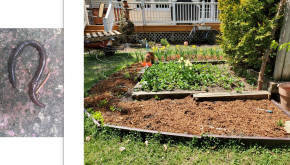
Jumping worms: Big Trouble
Jumping worms are relatively new invasive species in Minnesota and the upper midwest. All earthworms are invasive in Minnesota; the last glacial period killed any native earthworms that may have called Minnesota home. “Jumping worms” is actually the term for several species of worms in the Amynthas and Metaphire genera. Unlike most of our other invasive earthworms, jumping worms are causing great heartache for gardeners and significantly changing home gardening practices for those unlucky enough to have these lively and voracious pests.
There are a suite of non-native earthworms often found in the top 6 feet of soil in many of Minnesota’s managed ecosystems (some forests are still worm free). But for reasons that aren’t known, when jumping worms invade a site they seem to push out other worms. Jumping worms live in the top 8 inches of soil and can be twice as abundant as all the other worms combined that may have lived in the top 6 feet of soil before jumping worms invaded. This large volume of worms living in the top-most layer of soil eat many fine root hairs and have been known to kill plants, especially shallow rooted plants like hostas. Uniquely, jumping worms eat wood chips and overwinter as eggs in cocoons about the size and color of poppy seeds. These traits make them very easy to move and hard to spot. Jumping worm eggs can be spread in fall leaf management and removal, soil, in plants and via wood chips, including wood chips purchased from big box stores. Sadly there are no scientifically proven treatments for worms, including jumping worms, so the best management is prevention.
You can help
Be a savvy consumer. As the gardening itch becomes harder to ignore and a pretty flower offers a much needed ray of hope, don’t accidently bring home big trouble. Ask where the plants were grown. Green houses or plant nurseries that use weed free soil are likely worm and weed free. The same treatments that kill weed seeds should kill jumping worm eggs. Be wary of free plants, free soil or compost, and wood chips that have been sitting on soil or even those bagged and sold. Check out this web resource, intended for plant sale organizers but full of helpful information.
Spread the word about jumping worms and their methods of spread. I find few folks know about jumping worms until they’re found and then it’s too late to prevent their introduction. In my neighborhood, with the warming weather and home confinement, “Free” signs are popping up next to hostas, lilies and other common garden plants. Soil attached to these plants or the plants themselves may have jumping worm eggs or even tiny worms in or attached to them (See the video I took on Sunday in my garden: I’m pretty positive it’s a baby jumping worm. Jumping worms were confirmed in my yard two years ago.). Farmers market stalls now include plants dug up from their farms. Also, to prevent weeds and increase soil health and moisture retention, it’s common to put down wood chips, yet those too are a cause for concern. Finally, to further frustrate matters, the Olmsted County compost site was confirmed to have jumping worms a few years ago. They’ve been working hard to manage the worms there, but compost is a great vector for worms, including jumping worms.
Look for and report jumping worms. The University of Minnesota Extension has great information about jumping worm identification and reporting, check it out. Positive confirmation of jumping worms will be almost impossible until the worms are bigger, likely mid-July through autumn, but the rapid and squiggly movement can be a good indicator and was clearly noticeable in my garden this weekend. You can also inspect your soils and look for the coffee-grounds texture.
Have jumping worms? Help us learn about possible management strategies. UMN Extension is asking gardeners with jumping worms to help us better understand what type of management may reduce jumping worm impacts and which practices may not. If you’re managing a garden with jumping worms tell us about your experience: https://sites.google.com/umn.edu/invasive-species-citsci/jumping-worm-report-management
As Women Owning Woodlands please know that all earthworms are troublesome to Minnesota’s woods. The Great Lakes Worm Watch has lots of good information about worm impacts in forests, how to survey for and identify worms and other ways you can look for worm impacts in your woods. But sadly, as stated above, there are no known management strategies for worms especially those in your woods. Prevention is again the only management. You can be proactive by preventing the spread of jumping worms, sharing information with your friends and neighbors, reporting jumping worms if found, and sharing your experiences managing your garden after jumping worms.

